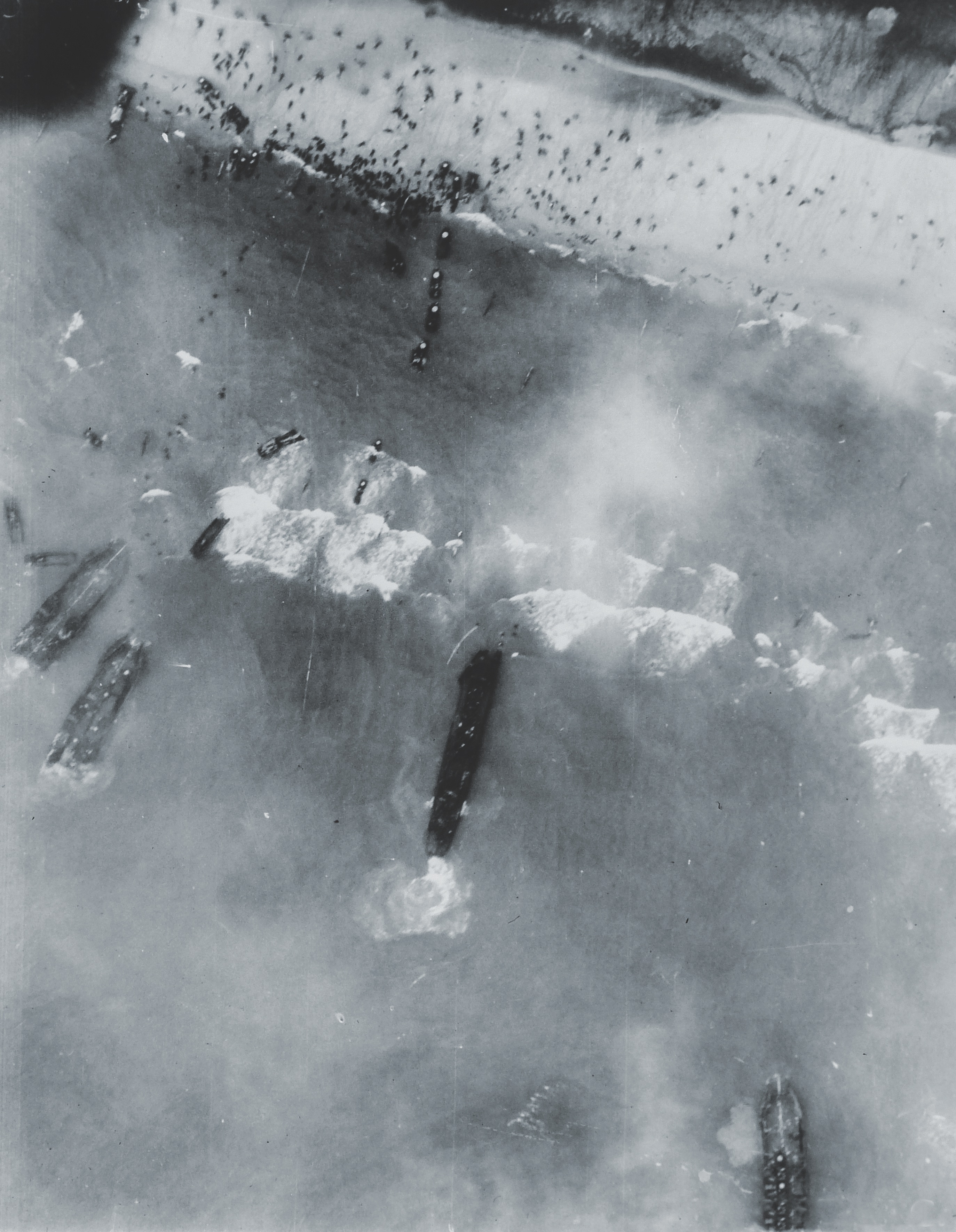Seaman Second Class Jack Edward Rowe’s 1944 voyage to France unfolds with disarming candor in a diary he left behind.
“FEBRUARY 10, 1944: I am glad to be leaving…it seems there is another job to be done in which I have the privilege of playing a part. I am going to describe my trip…in a hope that it will be of interest to those who read it.”
So began the shipboard diary of Seaman Second Class Jack Edward Rowe, United States Coast Guard, as he diligently recorded his experiences in 1944. He probably didn’t fully comprehend it yet, but the “job to be done” was the biggest and riskiest invasion of the war: Operation Overlord, the Allied assault on Nazi-occupied France. He did, however, understand that what he experienced as a coastguardsman would be a small part of a big war, and should be preserved. His insightful and highly personal diary provides a fascinating glimpse into the days and nights of one man leading up to D-Day.
Never blessed with lucid handwriting, Rowe stowed a small portable typewriter in his seabag and spent a few minutes each day pecking out his recollections, observations, and experiences. Jack was no admiral or staff officer involved in making key decisions; he was just a Seaman Second Class whose perspective was pretty much limited to a single ship. Yet his perceptive (and often witty) observations provide a unique voice to the history of World War II. In 2016, Rowe’s family, seeking to preserve his story and honor his legacy, donated the typescript diary, along with photographs and artifacts, to the National D-Day Memorial in Bedford, Virginia. Now part of the Memorial’s collection, the diary illuminates an oft-forgotten aspect of the Normandy invasion: the essential role of the U.S. Coast Guard, whose D-Day story is one of courage and sacrifice.
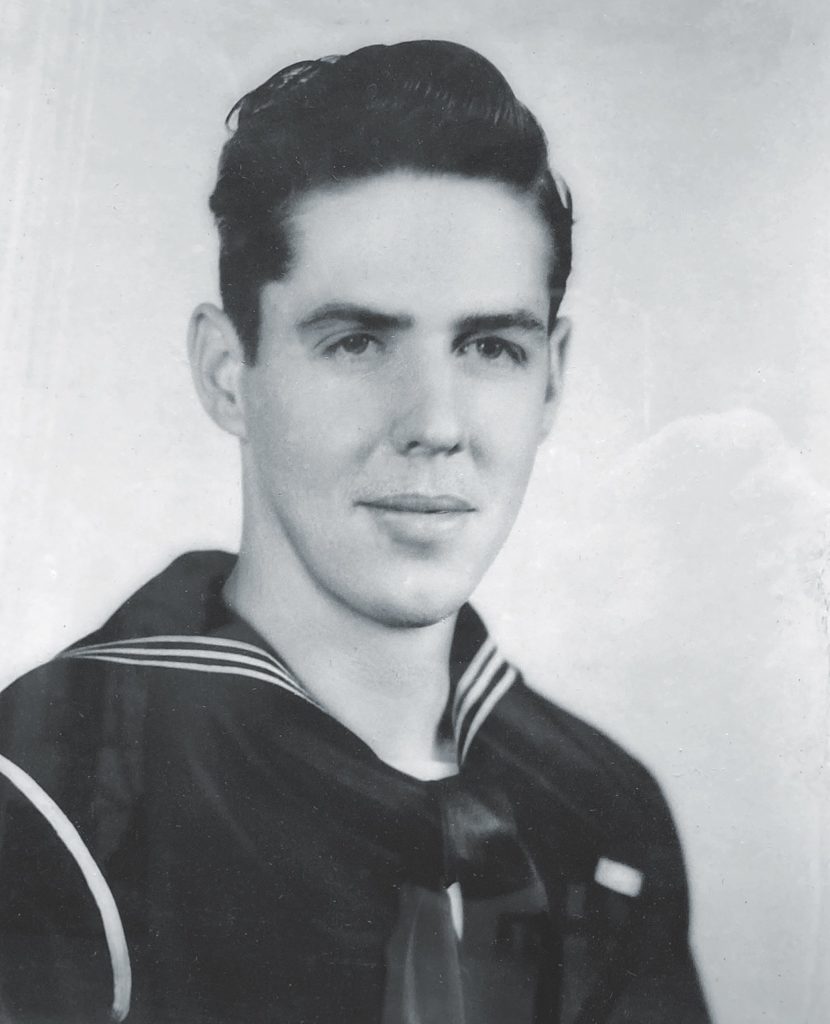
JACK ROWE WAS BORN IN 1922 in Rhode Island, the son of Raymond and Reba Rowe. He seemed to have a typical American boyhood during the Roaring Twenties and then the Great Depression, developing a love of reading, art, and sports. When the U.S. entered World War II, Jack, like most young men of his generation, put on a uniform: that of the U.S. Coast Guard Reserves.
By early 1944, the ruggedly handsome 21-year-old coastguardsman was serving aboard the attack transport USS Joseph T. Dickman (APA-13), named for the officer who commanded a division, two corps, and an army in World War I. The Dickman departed Norfolk, Virginia, on February 11, 1944, part of a convoy of, Jack estimated, “thirty-five or forty ships…transports (American and English), two aircraft carriers, a battlewagon, cargo ships and Navy tankers used in refueling the D.E.’s [destroyer escorts] and destroyers” that protected the convoy. The 10-day crossing was mostly uneventful to Rowe: “This is the most monotonous trip I have ever made anywhere.” But a wintry stint of rough seas added some excitement—and some discomfort to break the monotony. “I will now hit the sack, lie still and let my insides float up and down in a circular motion,” he noted toward the end of the journey.
On February 22 the Dickman reached its destination, revealed now to be Gourock, Scotland, on the Firth of Clyde about 30 miles west of Glasgow. Jack was captivated by the scenery he observed on either side of his ship: “I can’t seem to find words for the beauty of the shoreline, and since I couldn’t do it justice anyway, I’ll let it go at that.”
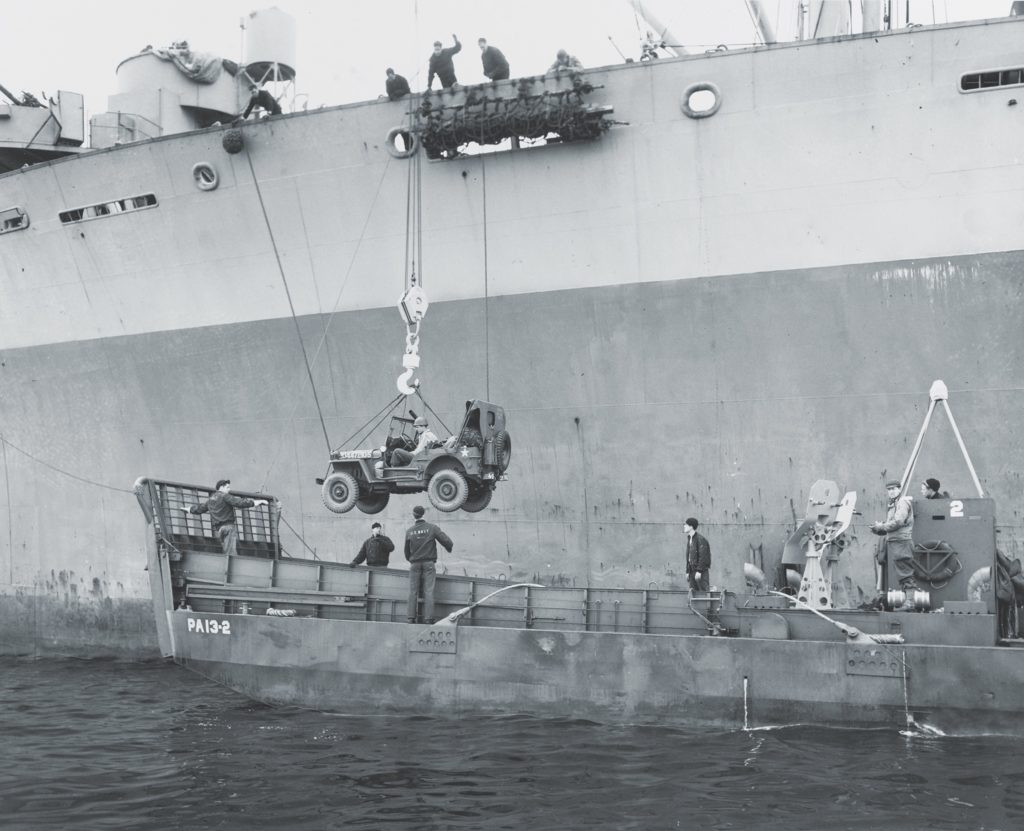
While in Scotland for the next three months, with occasional diversions to English ports, the men of the Dickman were kept busy with training exercises, not only sharpening their own skills for the impending invasion but helping the ground forces prepare for the challenges of an amphibious assault on the French coastline. Rowe’s specific job would be aboard an LCM—Landing Craft, Mechanized—housed aboard the Dickman. Less well-known but larger than the iconic LCVP (Landing Craft, Vehicle, Personnel) “Higgins Boat,” LCMs could transport dozens of troops or various combinations of vehicles, from jeeps to trucks to tanks. Getting these assets to the beach on D-Day would be crucial to the invasion’s success.
The rigorous training notwithstanding, Rowe often devoted more space in his diary to leisure activities than to his workaday tasks. Reading and movies were especially important to him as a way to break up the routine of shipboard life. Among the movies Rowe recorded seeing, along with his comments, were Captain Caution (“very good”), Jungle Book (“good”), Mister Big (“fair”), The Gorilla Man (“not very good”), and The Pride of the Yankees (“one of the best shows I have seen in a while”).
As for reading, Jack favored westerns, but he seemed content to turn the pages of whatever book came his way. End of the Trail, The Gambler Takes a Wife, All Night Long (about the Soviet war effort against Germany), Jungle Harvest, and The Owl Hoot Trail are only some of the books he finished during his tour. He reported that Pearl Buck’s The Promise was “very good, but also dry in spots.”
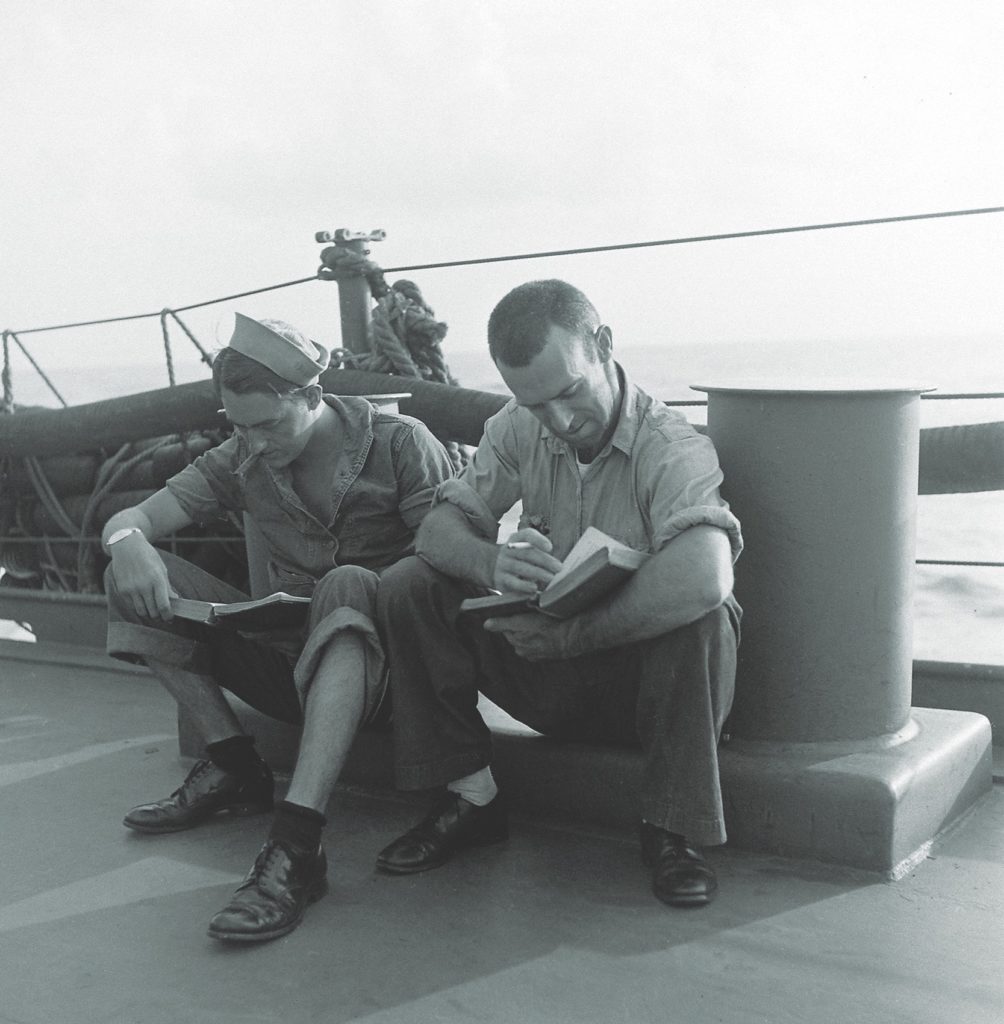
NOT SURPRISINGLY for a young man, one topic consumed his thinking above all others: the opposite sex. While Jack had a steady girl back home in Rhode Island, he was not averse to seeking out some female companionship when he could. And the good-looking American in uniform had little trouble attracting attention. He mentions taking several Scottish girls to dances or dinner.
One night in March Jack went on a blind date in Glasgow with the sister of a buddy’s girlfriend. Jack and this girl, Jessie Hammond (“long dark hair, big dark eyes, very good looking”), hit it off and would see each other several times in the coming weeks, as well as exchange letters. Jessie even offered to write Rowe’s mother in Rhode Island for him, a common trick for American servicemen to convey information to loved ones at home while avoiding wartime censorship.
Despite his platonic dalliance with Jessie, Jack remained committed to his girl back home (whom he never names) and even pondered popping the question when the Dickman returned stateside. However, he also expressed in places the universal concerns of young love in wartime. If he hadn’t heard from her for a while (and the mail was sporadic at best), he fretted: “It helps to know how things are at home and if your one and only still cares.” Later he wondered if “some 4-F or beach pounder” might steal her away. “Just kidding,” he consoled himself. “Or am I?”
In mid-April, Jack got another shore leave and arranged to meet Jessie in Glasgow as part of a triple date. While the other two couples went dancing, he found that Jessie had recently undergone an operation on her foot, so the couple stayed in for dinner and hours of conversation. Finally Jack took his leave, eager to catch the train back to his base to meet his early morning curfew. He got to a train station, but no train ever arrived. Worried, Jack began hoofing it to another station, but: “I ran into four civilians who were looking for trouble. They tried to stop me by various remarks but I kept going. Next, they tried force. They knocked me down from behind. I got up and hit one and kneed one in the groin—then ran like hell.”
The short delay was a costly one for the soon-to-be AWOL coastguardsman. “I got to the station just as the train was pulling out. Tried to get a taxi—no soap.” He soon met an American sailor who was in the same fix, and the two set out together to try to make it back to Gourock by curfew. But they quickly realized it was no use. Jack decided “to have a good time since I was in trouble—no more trains or buses until morning.”
Resigned to their fate, Jack and the sailor sat on the riverbank in Glasgow Green park south of town and chatted up two girls for a while before starting back toward the city center at 3:30 a.m. They had to dodge patrols of MPs looking for servicemen out after hours, but “finally at 0500 we found a place to sleep” in Glasgow.
The following morning, Jack’s plan to catch an early train was hampered by restrictions on enlisted men on the streets. MPs picked him up, but he was able to talk his way out of arrest and hide at a friend’s house for several hours. Finally, toward evening when he was again allowed to be seen out in public, he showed up at Jessie’s house for another homecooked supper. She didn’t greet him very enthusiastically, however. Jessie was furious that he’d missed his train. She understood his offense would likely cancel any further shore leaves—and any chance for the two to see each other for the foreseeable future.
Eventually he made his way back to his ship and sheepishly reported for duty. The wayward coastguardsman knew he couldn’t escape the consequences of his 24-hour AWOL adventure. Sure enough, three days later he appeared before the captain and was sentenced to 90 days without leave. He also would be denied a promotion that was due. But always cheerful and optimistic, Jack took his punishment in stride. “I guess at last I will save some money. I have been wondering how I was going to do it,” he consoled himself. Sardonically he noted the next day that “today starts 90 days on this lovely ship. I am really happy about it. I guess I have really found a home at last.”
Three months’ restriction didn’t seem so bad. The time would pass. He’d endure it. But what he couldn’t understand at the time was that the most important operation of the war was at hand. And Seaman Second Class Jack Edward Rowe would have a front-row seat for the Allied invasion of Europe.
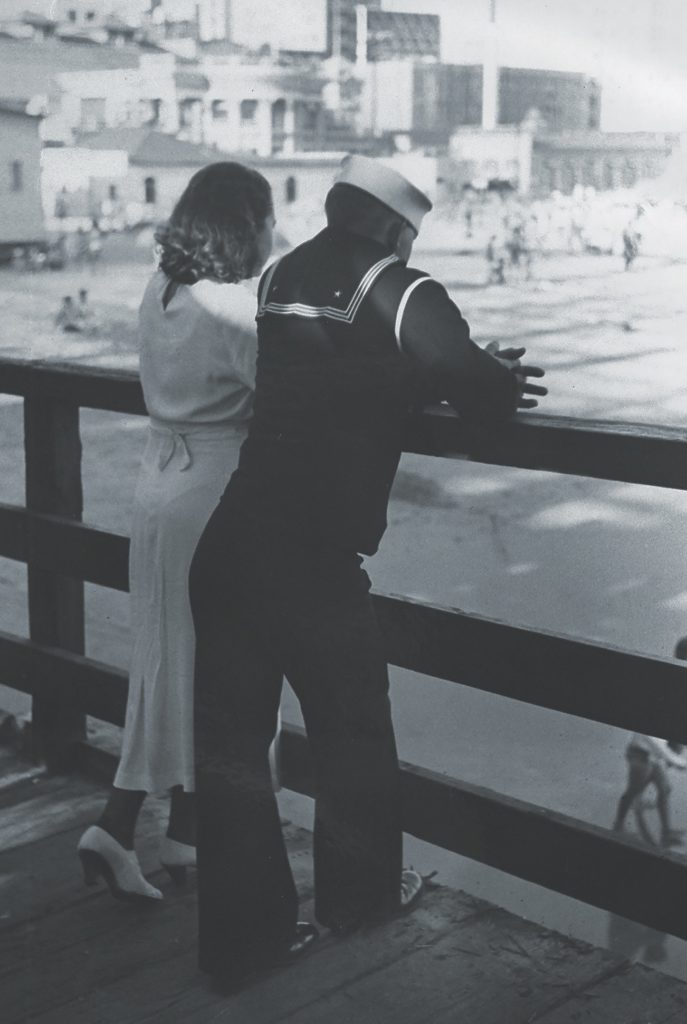
THE REST OF APRIL AND MAY passed with a steady drumbeat of trainings, practice exercises, and preparations for the invasion. Rumors were rampant about when it would be and where the landings would take place, but the observant coastguardsman picked up clues that the big day was approaching. One day he recorded a rumor, soon proved true, that the ship’s personnel records were going to be transferred to shore—“that means one thing. The invasion is not far off.”
On April 22, Rowe reported that the ship was getting underway, with the rumored destination Plymouth. The Dickman would soon moor there and at Torquay, on the southern Channel coast of England, over ensuing days. Jack described intense practice exercises, as his LCM was repeatedly lowered from crane-like davits “over the side” to make the mock run to pretend landing beaches. “Everything is done like the real thing,” he recorded. “Small and large craft are shelling the beach. Support boats using rockets. Soldiers using live ammunition. Shells bursting on the beach.”
Although Jack couldn’t know the extent of the maneuvers, this was part of Operation Tiger, a major test run for the invasion staged around Slapton Sands, south of Torquay. Jack did not mention, and almost certainly did not know, the sad sequel to Tiger. German E-boats (torpedo boats) successfully infiltrated the perimeter on April 28 and sank a number of Allied vessels carrying troops. More than 700 American soldiers perished in the icy waters, a fact that was covered up for decades.
For Jack, the days passed, with shipboard tedium punctuated by the rigors—and risks—of training. The Dickman busily shuttled between the Channel ports and Gourock, seldom staying in one place for long. Although still on restriction, he occasionally got ashore, running errands or piloting the launches that took more fortunate Coasties to liberty. He even met a “very attractive” English girl and had a “wonderful time with her” in a couple of chance encounters. During off-hours he read his westerns, saw whatever movies were shown on ship, and trained for boxing competitions. He also sketched prolifically and proficiently. An aficionado of drawing, he often decorated his companions’ seabags and wrote enthusiastically of applying to a correspondence school in Michigan for art. He thought it would be a good career move. The invasion was soon, and that meant the end of the war sometime after that. He had to choose a career, especially if he were to get married. Jack’s future awaited him, and he wanted to be ready for it.
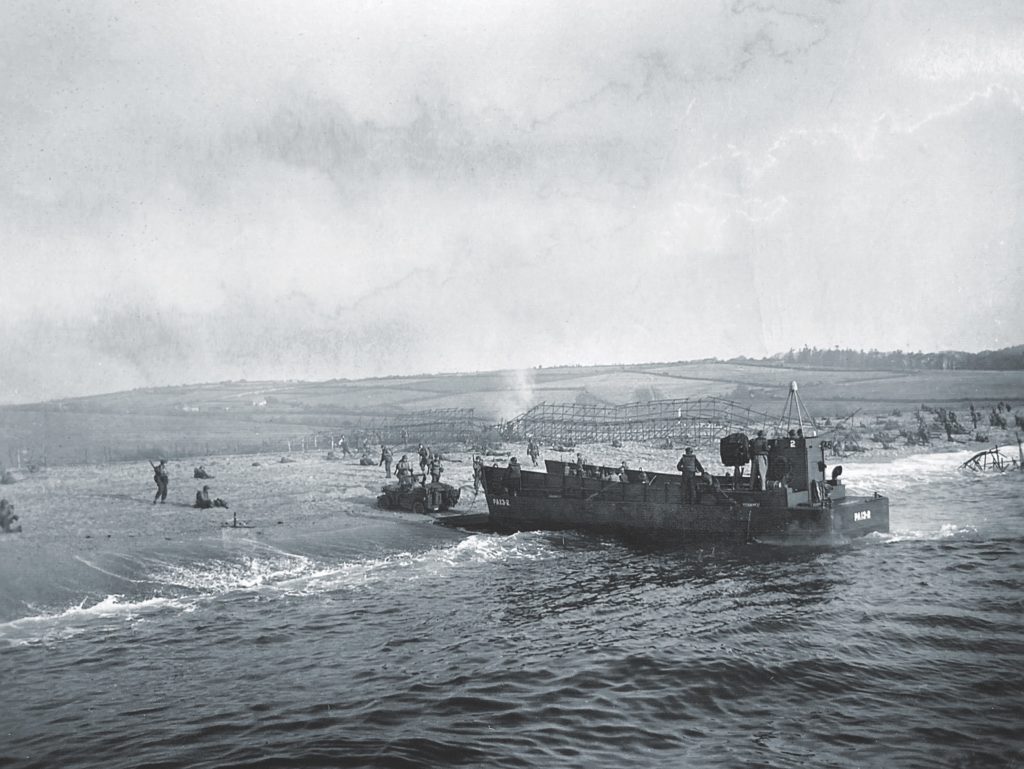
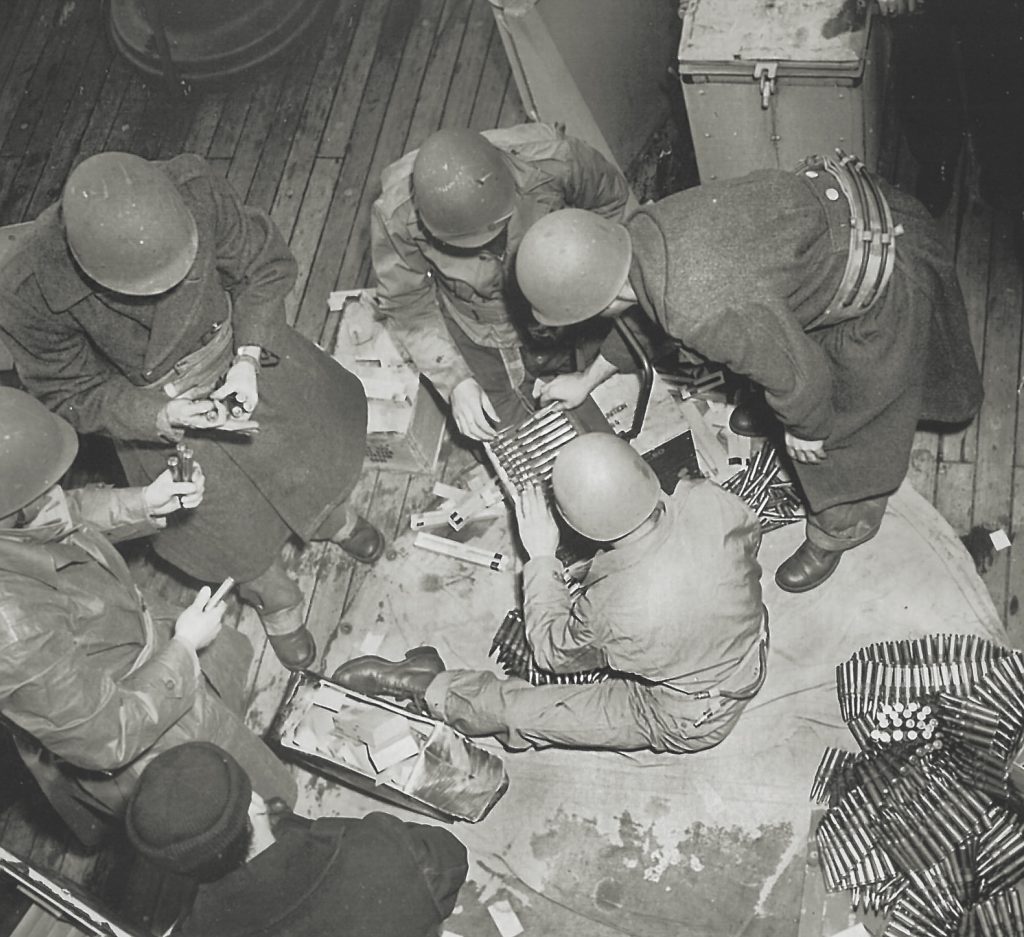
IN EARLY JUNE, Jack predicted that “we will invade Monday (morning) June 5.” He didn’t explain the reasons for his conclusion, but he was actually correct. The invasion was indeed set for the 5th; however, a massive storm front that day would move D-Day to the 6th.
At the same time Jack finally received something that fortified his courage: a letter from his “best girl,” containing a photograph. He pledged to carry it with him into battle when the time came.
The role of the U.S. Coast Guard in the Normandy invasion is often overlooked. Many are surprised to learn that the Coast Guard was even there. In fact, coastguardsmen served aboard naval and merchant vessels and rescue cutters, as well as crewing several of their own ships. These forgotten men would serve with valor and at great cost; indeed June 6, 1944, was the costliest day ever in the Coast Guard’s history in terms of vessels lost. But most at risk were the Coasties who piloted or crewed various landing craft, like Jack Rowe.
As the day approached, the crew of the Dickman received clarifying instructions as to their role in the risky assault. Jack’s LCM (PA-13-2) would ferry demolition teams of the 4th Infantry Division to a stretch of coastline designated Utah Beach. They were not to linger—landing craft like the LCM were too scarce and irreplaceable to remain under fire. They were to offload their troops and equipment and pull back for subsequent loads.
On June 4, the Dickman crew received a briefing (Jack called it a “briff”) on what to expect from the German defenders of Normandy. Undersea obstacles, probably mined, were a certainty; the Germans may ignite floating oil as a barrier; the Luftwaffe would prowl the skies. Particularly mentioned by Jack was the possibility of poison gas attacks on the landing beaches. While this fear proved to be unfounded, his commanders took the threat seriously, informing the men that “the chances of them using gas is 3 to 1.”
By the next day, the imminence of action had been confirmed, and the Dickman left as part of a convoy from the anchorage at Torquay. “Every other thing that floats is also with us. Battlewagons, heavy and light cruisers, destroyers, minesweepers, PCs, DE’s and PT boats.” In keeping with longstanding military tradition, the soon-to-be invaders received inspirational messages from the top brass. “While eating chow we were read some farewell addresses from various Generals and Lieutenant Generals. Lieutenant General Omar Bradley, General Montgomery, and some [other] English general. Eisenhower’s speech is to be passed out to us sometime this evening.”
That speech from the Supreme Commander was Ike’s “Order of the Day,” informing the men that he had “full confidence in their courage, devotion to duty, and skill in battle. We will accept nothing less than full Victory!”
The nervous tension on the ship was palpable, with some men trying to relax and others too apprehensive to sleep. “The fellows are taking showers, shaving, you would think they were going to see their girls…[some] are reading, trying to catch some sleep, talking about how they think things will be on the beach. Others are at church.”
Jack got only a short catnap, waking up at 11:30 p.m. to dress for the “rough and windy” weather. The day had come. He had trained for this extensively and had months to anticipate the invasion everyone knew must eventually come. At 12:30 a.m. on June 6, Jack Rowe paused to type out one last entry in his journal:
0030: Minesweepers are sweeping the way and dropping [marker] buoys as they go. The sky is being lighted up by constant flashes about two points off the starboard bell.
My shipmates are climbing out of the pits, some noisy as usual; some of the noisy ones are very quiet; others talking; making speeches in a kidding way; the heavy sleepers weaving around the compartment trying to wake up. It’s hard to tell who was putting on a show to cover up his feelings, but I think I spotted a couple. Most are glad the time is here at last. It has been tiresome waiting month after month for something you know is bound to happen.
Well, I have a few little odds and ends to do before I go over the side, so I guess I will be off now to see history made and the biggest show of any war yet of its type. When I come back I will have a lot to write about.
As to coming back, there is no doubt in my mind but that I will.
Jack’s confident closing sentence rings through history with tragic poignance. In fact, he would never return.
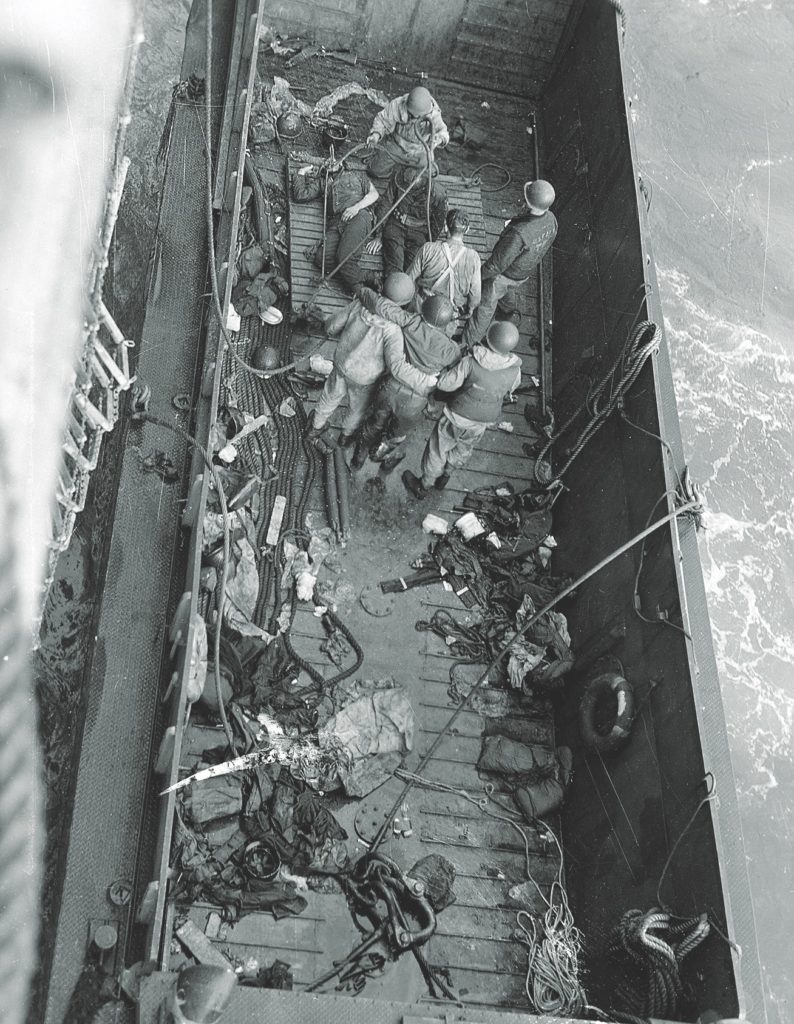
A CREWMATE ON ROWE’S LCM, Motor Machinist Mate 1st Class Robert Weik, would later record Jack’s fate. “Our boat had disembarked an army demolition squad. We had backed off the beach and were turning when we were hit from a German shore battery with what later proved to be an armor piercing shell…. Jack and I had laid down in the well of the boat to avoid being hit. Unfortunately for Jack, the shell exploded nearer to him.”
Grievously wounded, Jack was transferred to a destroyer, the USS Shubrick, where his buddies hoped he could receive better medical treatment than on the Dickman. But it was to no avail. The witty diarist with the terrible handwriting, the gentle artist who loved drawing designs on seabags, the dedicated coastguardsman who thought it a privilege to serve, would not survive. Jack Edward Rowe died aboard the Shubrick on D-Day and was taken back to England for burial. It would be years before his mother Reba would discover his actual resting place: in Cambridge American Cemetery. Some of Jack’s crewmates visited it with Reba every June 6 for the rest of her life.
Some 16 million Americans served in uniform in World War II. A quarter-million of these served in the U.S. Coast Guard. Some 400,000 Americans would give their lives. On D-Day itself, 2,502 U.S. servicemen are known to have been killed. Thirteen of them were coastguardsmen.
Jack Rowe was only one man out of these numbers. Yet, unlike the vast majority of his brothers-in-arms, he left behind a chronicle, an eloquent record of his last few months. His voice speaks to us across the decades, a powerful reminder that it was not anonymous statistics who died on D-Day. Individuals did—young men who once looked hopefully into the future, dreaming dreams that would never be fulfilled. ✯
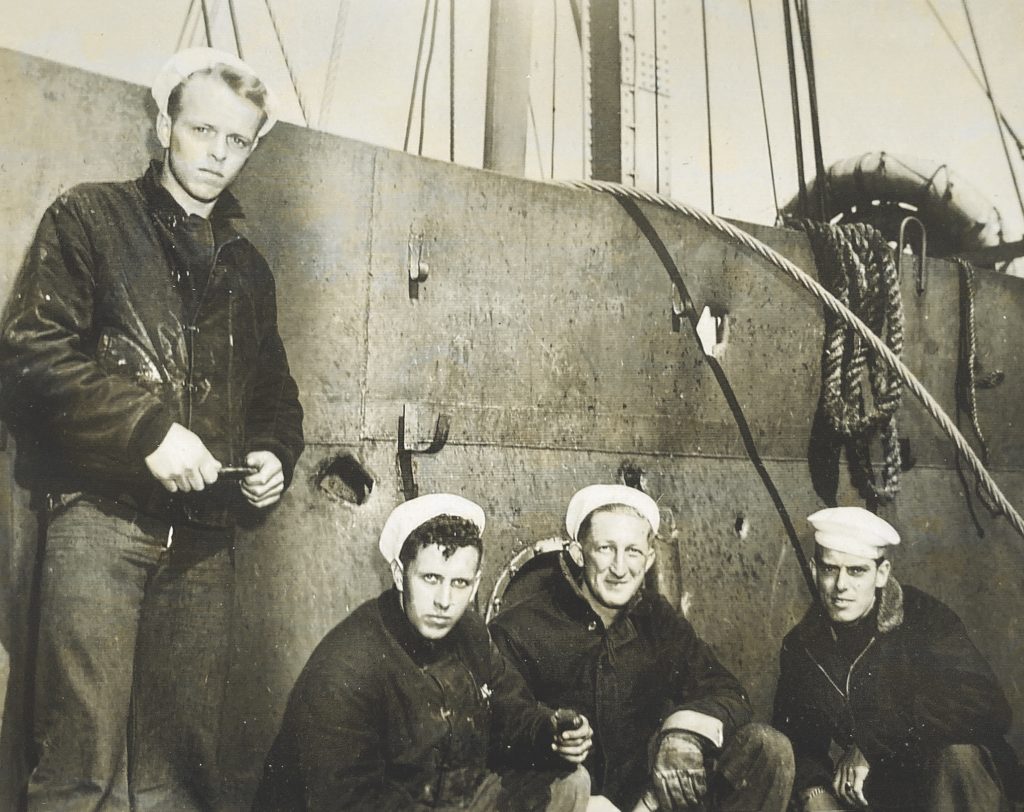
This article was published in the October 2020 issue of World War II.

